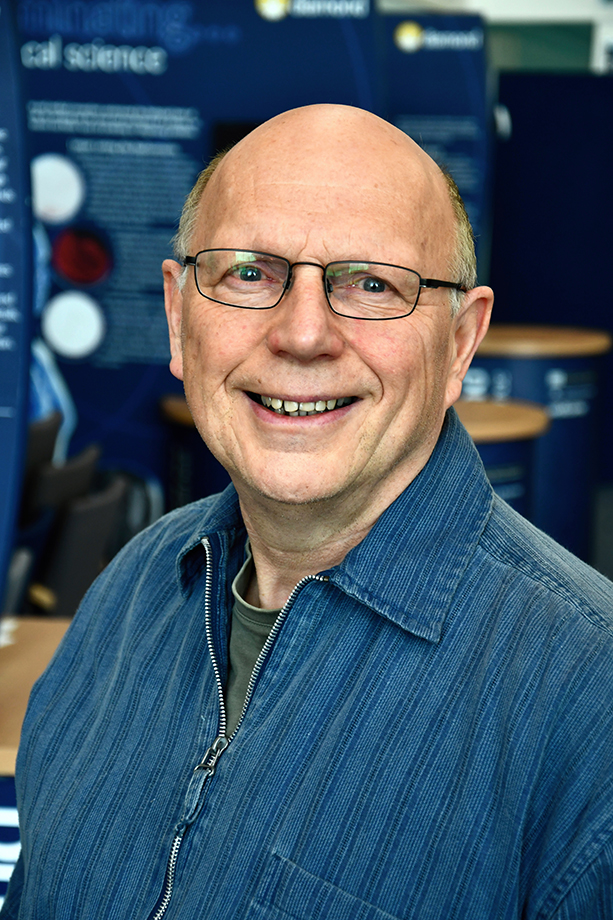Find out more about our ambitious upgrade project, delivering more brightness, more coherence, and greater speed of analysis to UK science. More about Diamond-II
![]()
Find out more about Diamond's response to virus research.
![]()
 Professor Gerrit van der Laan is a condensed matter physicist specialising in developing techniques that use polarised X-rays to study magnetism. He discovered X-ray magnetic dichroism and proposed the well-known orbital magnetisation sum rule, methods that are now used at every synchrotron around the world and which support the fundamental basis for the development of next-generation computing systems.
Professor Gerrit van der Laan is a condensed matter physicist specialising in developing techniques that use polarised X-rays to study magnetism. He discovered X-ray magnetic dichroism and proposed the well-known orbital magnetisation sum rule, methods that are now used at every synchrotron around the world and which support the fundamental basis for the development of next-generation computing systems.
Prof Gerrit van der Laan is a Diamond Senior Research Fellow and head of the Magnetic Spectroscopy Group. He began his career with a PhD in solid state and applied physics at Groningen University in the Netherlands, before working for the French Atomic Energy Authority (CEA) at Saclay and later at the French Synchrotron Radiation Facility (LURE), studying the magnetic structure of rare earth metals. He was responsible for the construction of two surface science beamlines at Daresbury Laboratory, before joining Diamond Light Source in 2007.
Although it was originally thought to be an effect too small to observe, Prof van der Laan discovered that X-rays can be used to measure magnetic materials – first via theoretical predictions, swiftly followed by experimental proof. The technique is now known as X-ray magnetic circular dichroism (XMCD), and it has become mainstream in physics and materials science.
XMCD is a measure of the difference in intensity of left- and right-circularly polarised X-rays as it passes through a magnetic sample. Originally measured in absorption experiments, it was found to work in all X-ray techniques, including reflection, scattering, diffraction, photoemission and imaging. As the only technique capable of distinguishing between the spin and orbital parts of magnetic moments, XMCD found applications across a wide range of disciplines, from physics, chemistry and biology to earth and environmental sciences. In 2000, Prof van der Laan received the prestigious Agilent Technologies Europhysics Award for his discovery and development of XMCD.
The main advantage of XMCD is that it is element specific – it can ‘see’ the magnetism of each different element that makes up a material. It’s a very useful technique for developing new materials that are doped with specific elements, allowing researchers to find out exactly how the magnetism can be manipulated to make use of the material in an electronic device.
Prof van der Laan is a regular user of the I10 beamline for Advanced Dichroism Experiments (BLADE), and was Chairman of the working group that brought it to life. It’s also home to RASOR (the Reflectivity and Advanced Scattering from Ordered Regimes end station), a soft X-ray diffractometer that allows scientists to probe the magnetic, charge and orbital structures of strongly correlated electron systems.
Prof van der Laan has continued to develop new techniques, including combining XMCD with ferromagnetic magnetic resonance (FMR). XFMR has emerged as a powerful synchrotron-based tool that can be used to study element-specific magnetization dynamics; it offers both magnetic and chemical contrast. This technique, in which the periodic oscillation of the magnetic moments under resonance is measured as a dynamic XMCD signal, has recently been ‘exported’ to the Advanced Light Source in the US.
An area of collaborative research with Oxford University is the study of chiral magnets, such as skyrmions - vortex-like magnetisation states. Soft X-ray resonant magnetic scattering is an ideal tool to interrogate these complex spin structures and to reveal their identity. Another research area is topological insulators, which can be considered as a new type of matter that is fascinating from a fundamental physics perspective. The inside of these materials is an insulator, while at the surface an electronic current flows that is topologically protected, which makes it robust against any local perturbations. Doping the topological insulator with magnetic impurities, which electronic structure can be inspected by XMCD, offers a potential route of low-energy, next-generation data storage devices.
In a collaboration with the group of Dr Neil Telling at Keele University, XMCD has also been used for a very different kind of study – investigating whether iron particles play a role in the development of Alzheimer’s disease. Iron occurs naturally in the human body, and is converted between two different forms in regular biological processes. However, one of these forms - ferrous iron - can be highly toxic. Scientists already knew that ferrous iron builds up in the brain lesions caused by Alzheimer’s disease, but using synchrotron light the team was able to watch iron changing into the more toxic ferrous form, paving the way for future investigations that could develop treatments to limit this transformation, and the brain damage that it causes.
Cutting-edge fundamental and applied research is all in a day’s work for Prof van der Laan, who describes his role simply as “scrutinising magnetic materials using polarized X-rays.” During his 10 years at Diamond he has published over 200 scientific papers, resulting in a total of over 500 papers. He’s also a Fellow of both the Institute of Physics and the American Physical Society.
Diamond Light Source is the UK's national synchrotron science facility, located at the Harwell Science and Innovation Campus in Oxfordshire.
Copyright © 2022 Diamond Light Source
Diamond Light Source Ltd
Diamond House
Harwell Science & Innovation Campus
Didcot
Oxfordshire
OX11 0DE
Diamond Light Source® and the Diamond logo are registered trademarks of Diamond Light Source Ltd
Registered in England and Wales at Diamond House, Harwell Science and Innovation Campus, Didcot, Oxfordshire, OX11 0DE, United Kingdom. Company number: 4375679. VAT number: 287 461 957. Economic Operators Registration and Identification (EORI) number: GB287461957003.